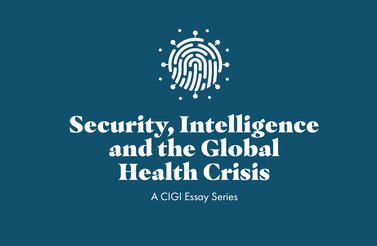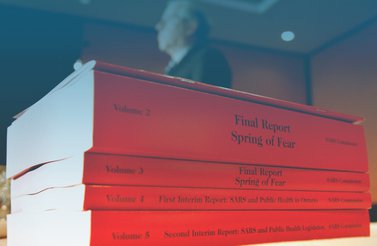his series of essays is built on a simple but foundational assumption: governments that know better do better, provided the political will exists.
Early warning was vital to meet an unprecedented global pandemic as COVID-19 emerged in China and began its lethal spread. But there are many signs that traditional warning mechanisms did not function as expected in this situation. Media reports indicate that the Canadian Global Public Health Intelligence Network (GPHIN), a critical early warning system run by the Public Health Agency of Canada, meant to serve an international clientele, including the World Health Organization (WHO), effectively “went dark” in May 2019, seven months before a pandemic alert system would be needed most. International understanding of the potential severity of the pandemic was further hampered by early problems in reporting on the outbreak from China. According to a report from the US Department of Homeland Security, “the Chinese government intentionally concealed the severity of COVID-19 from the international community in early January while it stockpiled medical supplies by both increasing imports and decreasing exports.” The WHO, the international system’s portal for disease outbreak intelligence, was reliant on China’s cooperation and was inhibited in its own efforts to provide accurate information.
Evaluating how crucial global health intelligence should be generated, assessed, reported to policy makers in a timely way and shared will be one of the key lessons from this experience for countries around the world.
Another key and congruent lesson to be learned from COVID-19 is the urgent need to reconceptualize doctrines of national security. A national security strategy is ultimately a framework for knowing “better.”
With COVID-19, we have seen cyberattacks and disinformation campaigns launched by adversarial state actors; the domestic deployment of the Canadian and Australian militaries, among other national forces, to protect vulnerable populations; the disruption and vulnerability of just-in-time global supply chains; worrying domestic political tensions and fractures in many states; and an erosion of international cooperation. All of this is taking place amid ongoing tectonic geopolitical shifts, bookended by climate change and an overdue discussion about data, tracking, commercial surveillance and the attention economy.
A notable feature of existing national security doctrine is the willingness to identify pandemics as a national security threat, without building a sufficient response capability, and while largely decoupling this threat from a traditional understanding of the role and functions of security and intelligence systems. In our view, this needs to change, and change needs to be driven by exchanges among like-minded states and, ultimately, by public debate.
One important forum for discussions of a new approach to national security is the Five Eyes alliance (comprising Australia, Canada, New Zealand, the United Kingdom and the United States). The Five Eyes partnership has, over the past decade, expanded its scope beyond intelligence sharing to incorporate dialogue on key geopolitical and economic concerns. While it is a small and tight club of “Anglosphere” states, it could serve as an important sounding board.
A survey of pre-COVID-19 national security doctrine among the Five Eyes provides a sense of how its individual members may need to pivot to face the future.
Among the Five Eyes, New Zealand is unique in that it has no current national security strategy or any recent precedent for creating one. But as Joe Burton argues in his essay for this series, “COVID-19 presents an opportunity for a deeper rethink about what we mean by security in the New Zealand context.” He calls for a new approach that would put emphasis on human security, a doctrine of economic resilience and an all-hazards risk framework.
Australia shares a history with Canada of paying only episodic attention to national security strategies. The last Australian doctrine, Strong and Secure: A Strategy for Australia’s National Security, was issued in 2013.
The key risks identified in the Australian national security strategy would certainly need a rethink. The six core risks ranged from espionage and foreign interference, to malicious cyber activity and state-based conflict or coercion significantly affecting Australia’s interests. The China threat subtext was implicit. None of these risks have gone away and many have increased in amplitude since 2013. But the Australian strategy made almost no mention of pandemic threats or climate change security impacts.
As Patrick Walsh argues, “a first point for a post-COVID-19 policy framework is for the government and national security intelligence enterprise to move beyond the rhetoric of pandemics being a ‘national security issue’ to operationalizing these words in a political and bureaucratic sense.” He has specific recommendations in this regard but also notes the cultural issues involved for the Australian intelligence and security system in moving pandemic threats into the national security space. Walsh’s identification of the problem of “two tribes” (health and security) certainly resonates across the Five Eyes.
Among the two leading powers in the Five Eyes alliance (the United Kingdom and the United States), the problem of dated national security strategies and siloed approaches to public health and national security looks, at least on paper, less pervasive. Both countries have produced a series of national security strategies and both have recent pre-COVID-19 biological security strategies. The question then becomes: do these two countries serve as models for the rest of the Five Eyes partnership in their doctrinal approaches to national security and health security strategy?
The United Kingdom produced its first national security strategy in March 2008. It set out a new understanding of national security for the United Kingdom, explained in this way:
In the past, the state was the traditional focus of foreign, defence and security policies, and national security was understood as dealing with the protection of the state and its vital interests from attacks by other states. Over recent decades, our view of national security has broadened to include threats to individual citizens and to our way of life, as well as to the integrity and interests of the state. That is why this strategy deals with transnational crime, pandemics and flooding — not part of the traditional idea of national security, but clearly challenges that can affect large numbers of our citizens and which demand some of the same responses as more traditional security threats, including terrorism.
This was a bold statement. It elevated the understanding of the threats posed by pandemics and climate change impacts to a high level and, just as important, argued that the approach to these non-traditional security threats contained many elements similar to those deployed against more traditional concerns, including terrorism. These elements included monitoring (intelligence collection) and risk assessment, the development of response capabilities and the inculcation of societal resilience.
Subsequent iterations of the British national security strategy suggest the bold new outlook never fully took hold. The most recent update to the British national security strategy was produced in 2018. Pandemics were included in a general category of national security threats, labelled “diseases and natural hazards affecting the UK.” Discussion of specific responses to pandemic threats was off-loaded to a separate biosecurity review, produced in July 2018.
The UK Biological Security Strategy extolled the capabilities and systems available within the United Kingdom while calling for greater integration of effort, sustained attention to the threat and support for developing countries to help improve their capabilities. Disease outbreaks were identified as a major globalized threat to society while accidental release of a virus or deliberate biological attacks were seen as less likely (high impact but low probability). The UK strategy maintained a traditional distinction between the role of intelligence services in collecting information regarding deliberate threats (largely from malicious state actors), and the conduct of epidemiological intelligence by civilian public health authorities and experts in Britain and through international partnerships. The key role played by the WHO’s Health Emergencies Programme was acknowledged alongside Britain’s financial contribution to it. The WHO was described as having “a world leading surveillance and information network filtering 5000 disease signals a month looking for outbreaks of pandemic potential.”
It is safe to say that key assumptions built into the 2018 UK Biological Security Strategy, such as the distinction between state-sponsored biological threats and naturally occurring pandemics, and the singular reliance on the WHO for global surveillance, have been made dangerously obsolete by COVID-19. The creation of a new Joint Biosecurity Centre in May 2020 to act as an intelligence fusion and response mechanism is one early indicator of new thinking.
A new national security strategy will have to address a complex threat environment and will have to shake itself loose from an overweening attention to terrorism.
The United States is the lead power, by far, in the Five Eyes alliance, with dominant military and intelligence capabilities and far-reaching global interests and power-projection throw-weight. Successive US administrations have taken the lead since the September 11 attacks in promulgating high-profile national security strategies. The process was begun by President George H. W. Bush in September 2002, with a strategy that set the United States on a course of global counterterrorism and expansive democracy promotion, which provided the underpinnings for its costly interventions in Afghanistan and Iraq.
The most recent US national security strategy dates from midway through the presidency of Donald Trump. Not surprisingly, Trump wanted to put a distinctive stamp on his own strategy and to distance himself from his predecessors. He did so with a forceful expression of an America-first policy and what the strategy describes as a philosophy of “principled realism.” The realism component acknowledges what the strategy calls the “central role of power in international politics.” The principle is very America-first oriented: “grounded in the knowledge that advancing American principles spreads peace and prosperity around the globe.” Within such a construct, pandemic threats got very short shrift. The half-page devoted to them mixed a discussion of naturally emerging threats and deliberate bioweapon attacks. The short discussion about detecting such threats talked about working with other countries, improving health services in developing countries and locking down laboratories to prevent accidental or criminal releases. Perhaps not surprisingly, no mention is made of the role of international institutions, such as the WHO, or multilateral bodies, including the Five Eyes intelligence alliance.
In the year following the implementation of the Trump national security strategy, the US government also produced a National Biodefense Strategy. Like the national security strategy, the biodefence paper involved a deliberate rejection of previous approaches, especially the more globalist and public health-oriented strategies produced by the Obama administration.
The US biodefence strategy, like its British counterpart, invoked good principles of readiness and leadership against globalized threats. Unfortunately, much of its guidance on the key role to be played by the federal government domestically and internationally in the event of a disease outbreak was not followed in practice when COVID-19 began its devastating attack on the US homeland.
The very first goal identified in the 2018 US biodefence strategy was “risk awareness.” Unlike the British approach, which suggested a limited function for intelligence focused on information about deliberate or state-sponsored biological threats, the US conception called for a strong role for intelligence in strategic understanding across the range of biological threats, combining efforts at timely reporting and analysis, strategic warning, research, periodic risk assessment, forecasting and informed planning scenarios. The early warning mission was especially clear and ambitiously framed: “provide strategic warning for, and assess the potential impacts of, diseases with the potential to affect U.S. national security or interests abroad, including assessments of the potential cascading effects (e.g,. economic, societal and governmental impacts).”
Across the Five Eyes, the intelligence enterprise of the United States is often seen as a class apart, given its size, resources and global reach. Other Five Eyes partners, in looking at the distinctive US approach to biosecurity, will have to decide whether the strategic warning role accorded to the US intelligence system is merely a product of the enterprise scale, or a function of need and advantage when it comes to addressing the national security threats posed by disease outbreaks. A fair reading of the US biosecurity strategy will also have to focus on its principles and set aside its shambolic implementation.
Where does Canada fit in this survey of Five Eyes national security strategies and biosecurity approaches? The answer is: on the margins. Canada has never produced an overarching biosecurity strategy, unlike Britain and the United States. Its one attempt at a national security strategy was produced 16 years ago and has been forgotten. The 2004 Securing an Open Society: Canada’s National Security Policy deserved a better fate. It might have served as a useful construct if it had been sustained and adapted to a changing national security environment. Its emphasis on an “all-hazards” understanding of national security threats, its identification of intelligence as the country’s first line of defence against all manner of threats, its attention to public health threats in the aftermath of the severe acute respiratory syndrome epidemic, and its call for closer integration of public health and national security were all important attributes. But this concept of national security withered away, to be replaced by more sectoral attention to individual threats posed by terrorism, cyberattacks and violent extremism. Over time, repeated public reference to terrorism as the number one threat to national security militated against new and broader thinking.
A long-overdue reappraisal of Canadian strategic approaches to national security will have to emerge in a post-COVID-19 environment. The groundwork needs to be laid in a clear-eyed appraisal of the Canadian government’s response to the pandemic and the nature of the role played by security and intelligence agencies, which has been largely obscured by doctrines of secrecy, failures of transparency and glib political messaging. Canada should not be content to continue to sit on the margins of strategic thinking about national security. As Canada revamps its own approach to national security, there are things it can learn from efforts by its Five Eyes partners.
The challenge to reforming national security strategy in the aftermath of COVID-19 should not be underestimated. Coming up with a meaningful and evergreen strategy will be difficult and will face bureaucratic resistance and a possible absence of political champions, given that the practice has not been embedded in Canadian political culture. A new national security strategy will have to address a complex threat environment and will have to shake itself loose from an overweening attention to terrorism. When it comes to giving attention to the pandemic threat, it will have to resist the urge to fight the last war and better prepare for future encounters with pandemics in a proportional and balanced way, recognizing that public health and national security can no longer be entertained as separate and disconnected spheres of government responsibility. A new integration between the two will have to be explained in a way that satisfies public expectations about keeping Canada safe while respecting core values and civil liberties.
But if the challenges to reformulating national security doctrine are great, in Canada as in other countries, so are the potential payoffs. These include a wider scope of thinking about what constitutes national security threats, freed from the albatross weight of legacy concerns; a more cohesive whole-of-government approach; greater and more proportional linkages between identified threats and response capabilities; renewed attention to the significance of early warning, intelligence collection and risk assessment; and improved public understanding. The need for a new approach to national security embedded in a new national security strategy must, in our view, be one of the outcomes of the terrible experience of the current pandemic, to ready us for the next.



